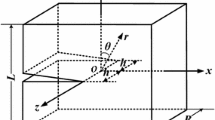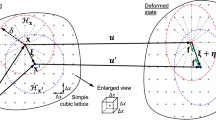Abstract
The effect of out-of-plane constraint associated with a thickness on the toughness of three-dimensional bodies is a primary concern in fracture mechanics. The \(J - \Delta \sigma\) approach has been shown to be capable of quantifying crack tip constraint loss in high and low constraint geometries using a deformation parameter, \(J/z\sigma_{o}\). The present study is motivated to use the parameter to assess the nature of out-of-plane constraint loss under Mode-I loading in a deeply cracked compact tension (CT) specimen. The assessment focuses on the variation in crack tip stress fields across the specimen thickness, which was examined through finite element analysis of full-field CT models in comparison with two-dimensional plane strain and plane stress solutions to identify the constraint loss pattern. The models with a sharp crack tip were constructed using quadratic brick elements and subjected to a displacement-controlled loading that corresponded to a limit load analysis. The results show that the state of three-dimensional stress fields in CT specimens departs from a plane strain condition at the midplane to a plane stress field near the free surface. Using the parameter \(J/z{\sigma }_{o}\), the loci of out-of-plane constraint loss in different specimen thicknesses subjected to varying deformation levels were unified into a single curve, and thus verifying the capability of the \(J - \Delta \sigma\) approach to characterize the out-of-plane constraint loss in high constraint geometries of deeply cracked CT specimens.










Similar content being viewed by others
References
C. Betegón, J.W. Hancock, Two-parameter characterization of elastic-plastic crack-tip fields. J. Appl. Mech. 58, 104–110 (1991)
N.P. O’Dowd, C.F. Shih, Family of crack-tip fields characterized by a triaxiality parameter—I. Structure of fields. J. Mech. Phys. Solids. 39, 989–1015 (1991)
Y. Kim, X.K. Zhu, Y.J. Chao, Quantification of constraint on elastic–plastic 3D crack front by the J-A2 three-term solution. Eng. Fract. Mech. 68, 895–914 (2001)
H. Yuan, G. Lin, A. Cornec, Quantifications of crack constraint effects in an austenitic steel. Int. J. Fract. 71, 273–291 (1995)
W. Brocks, J. Olschewski, On J-dominance of crack-tip fields in largely yielded 3D structures. Int. J. Solids Struct. 22, 693–708 (1986)
M. Nevalainen, R. Dodds Jr., Numerical investigation of 3-D constraint effects on brittle fracture in SE(B) and C(T) specimens. Int. J. Fract. 74, 131–161 (1995)
N.P. O’Dowd, Applications of two parameter approaches in elastic-plastic fracture mechanics. Eng. Fract. Mech. 52, 445–465 (1995)
T. Pardoen, Y. Marchal, F. Delannay, Thickness dependence of cracking resistance in thin aluminium plates. J. Mech. Phys. Solids. 47, 2093–2123 (1999)
H. Yuan, W. Brocks, Quantification of constraint effects in elastic-plastic crack front fields. J. Mech. Phys. Solids. 46, 219–241 (1998)
J.C. Newman, C.A. Bigelow, K.N. Shivakumar, Three-dimensional elastic-plastic finite-element analyses of constraint variations in cracked bodies. Eng. Fract. Mech. 46, 1–13 (1993)
J.C. Newman, J.H. Crews, C.A. Bigelow, D.S. Dawicke, Variations of a global constraint factor in cracked bodies under tension and bending loads. ASTM Spec. Tech. Publicat. 94, 34385 (1994)
W. Guo, Elastoplastic three dimensional crack border field—I. Singular structure of the field”. Eng. Fract. Mech. 46, 93–104 (1993)
A. Neimitz, J. Galkiewicz, Fracture toughness of structural components: influence of constraint. Int. J. Press. Vessels Pip. 83, 42–54 (2006)
J. Hebel, J. Hohe, V. Friedmann, D. Siegele, Experimental and numerical analysis of in-plane and out-of-plane crack tip constraint characterization by secondary fracture parameters. Int. J. Fract. 146, 173–188 (2007)
V.N. Shlyannikov, N.V. Boychenko, A.M. Tartygasheva, In-plane and out-of-plane crack-tip constraint effects under biaxial nonlinear deformation. Eng. Fract. Mech. 78, 1771–1783 (2011)
F. Yusof, K.H. Leong, Elastic-plastic J-Tz dominance in bending and tension loadings. Int. J. Struct. Integr. 10, 644–659 (2019)
L.-Z. Jin, C.-Y. Zhou, Q. Pei, Y.-S. Fan, L. Chang, X.-H. He, Investigation on in-plane and out-of-plane constraint effects for plates with I-II mixed mode cracks under biaxial compressive loading. Theoret. Appl. Fract. Mech. 117, 103160 (2022)
L.-Z. Jin, Q. Pei, C.-Y. Yu, L. Chang, X.-H. He, C.-Y. Zhou, T-stresses solution and out-of-plane constraint for central cracked plate (CCP) with I-II mixed mode crack under uniaxial compression. Theoret. Appl. Fract. Mech. 115, 103040 (2021)
R.H. Dodds, T.L. Anderson, M.T. Kirk, A framework to correlate a/W ratio effects on elastic-plastic fracture toughness (J c). Int. J. Fract. 48, 1–22 (1991)
J. Yang, G. Wang, F. Xuan, S. Tu, Unified characterisation of in-plane and out-of-plane constraint based on crack-tip equivalent plastic strain. Fatigue Fract. Eng. Mater. Struct. 36, 504–514 (2013)
Y.G. Matvienko, The effect of crack-tip constraint in some problems of fracture mechanics. Eng. Fail. Anal. 110, 104413 (2020)
X. Huang, Roles of in-plane and out-of-plane T-stresses in crack tip plastic zones and fracture toughness under mixed mode I/II loading. Eng. Fract. Mech. 277, 108990 (2023)
G. He, C. Bao, L. Cai, Study on uniform parameters characterizing the crack-tip constraint effect of fracture toughness. Eng. Fract. Mech. 222, 106706 (2019)
X. Huang, Y. Liu, X. Huang, New constraint parameters based on crack tip plastic zone: Theoretical derivations and effectiveness verification. Int. J. Solids Struct. 190, 129–147 (2020)
F. Yusof, Three-dimensional assessments of crack tip constraint. Theoret. Appl. Fract. Mech. 101, 1–16 (2019)
ASTM (2012). ASTM E399–12e2. Standard test method for linear-elastic plane-strain fracture toughness KIc of Metallic Materials.
ABAQUS (2012). ABAQUS v6.12 User's Manual. Dassault Systèmes Simulia Corp., Providence, Rhode Island.
A.G. Miller, Review of limit loads of structures containing defects. Int. J. Press. Vessels Pip. 32, 197–327 (1988)
R. McMeeking, D. Parks, On criteria for J-dominance of crack-tip fields in large-scale yielding. Elastic-Plastic Fracture, ASTM STP. 668, 175–194 (1979)
C.F. Shih, M.D. German, Requirements for a one parameter characterization of crack tip fields by the HRR singularity. Int. J. Fract. 17, 27–43 (1981)
J.R. Rice, D.M. Tracey, On the ductile enlargement of voids in triaxial stress fields. J. Mech. Phys. Solids. 17, 201–217 (1969)
R.O. Ritchie, J.F. Knott, J. Rice, On the relationship between critical tensile stress and fracture toughness in mild steel. J. Mech. Phys. Solids. 21, 395–410 (1973)
K.H. Leong, Constraint loss estimation schemes in deep and shallow three-dimensional crack tip fields. (Universiti Sains, Malaysia School of Mechanical Engineering, Penang, 2017)
C.F. Shih, Tables of Hutchinson-rice-Rosengren singular field quantities. (Division of Engineering, Brown University, Providence, R.I., 1983)
Acknowledgments
The authors would like to thank Universiti Sains Malaysia (USM) for financial support through the Short-Term Grant: 304/PMEKANIK/6315355.
Author information
Authors and Affiliations
Corresponding author
Additional information
Publisher's Note
Springer Nature remains neutral with regard to jurisdictional claims in published maps and institutional affiliations.
This article is an invited paper selected from presentations at the 6th Symposium on Damage Mechanism in Materials and Structures (SDMMS 2022), held August 16–17, 2022 in Kuantan, Malaysia. The manuscript has been expanded from the original presentation. The special issue was organized by Nasrul Azuan Alang, Norhaida Ab Razak, and Aizat Alias, Universiti Malaysia Pahang.
Rights and permissions
Springer Nature or its licensor (e.g. a society or other partner) holds exclusive rights to this article under a publishing agreement with the author(s) or other rightsholder(s); author self-archiving of the accepted manuscript version of this article is solely governed by the terms of such publishing agreement and applicable law.
About this article
Cite this article
Yusoff, N., Yusof, F. J−Δσ Quantification of Out-of-Plane Constraint Loss in Mode-I Fracture. J Fail. Anal. and Preven. 23, 556–568 (2023). https://doi.org/10.1007/s11668-023-01617-8
Received:
Revised:
Accepted:
Published:
Issue Date:
DOI: https://doi.org/10.1007/s11668-023-01617-8




